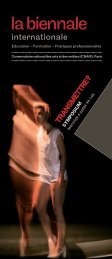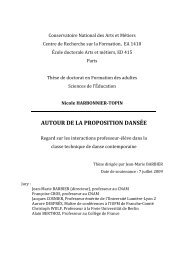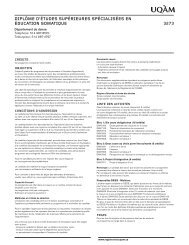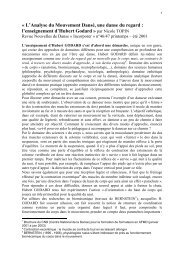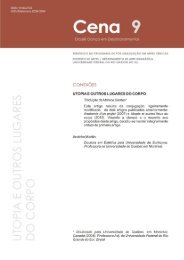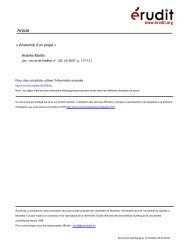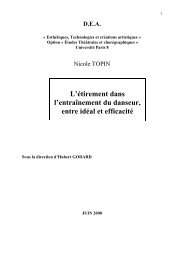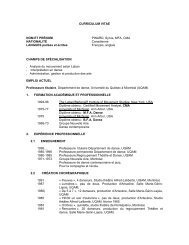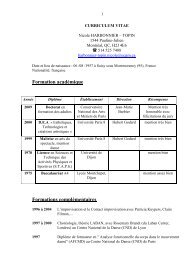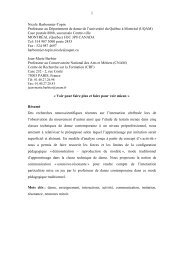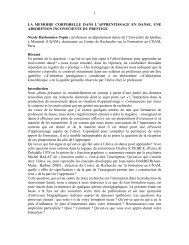Day 2 - Département de danse - UQAM
Day 2 - Département de danse - UQAM
Day 2 - Département de danse - UQAM
Create successful ePaper yourself
Turn your PDF publications into a flip-book with our unique Google optimized e-Paper software.
d) Eco-Criticism @ the Edge Fine Arts 103<br />
Curated Panel Mo<strong>de</strong>rator: Sheila Rabillard (University of Victoria)<br />
“‘Walking with Our Hearts’: Eco-critical perspectives on Daniel MacIvor’s The Best Brothers”<br />
Karen Bamford (Mount Allison University)<br />
Drawing on the work of eco-critics (Una Chaudhuri, John Simons), animal ethicists and advocates (Vicky Hearne, Kathy<br />
Rudy), and moral philosophers (Michael Bradie, Peter Carruthers), this paper analyzes Daniel MacIvor’s representation of the<br />
human-canine relationship in his recent play The Best Brothers. A commercial and critical success in the Stratford Festival’s<br />
2012 season, the play marks a significant <strong>de</strong>parture from MacIvor’s previous body of work. Although it shares with other of his<br />
recent plays a thematic concern with <strong>de</strong>ath, mourning, maternity, its mo<strong>de</strong> is thoroughly comic, both in the sense that it elicits<br />
laughter from its audience and also in its plot structure: it conclu<strong>de</strong>s with the reconciliation of “enemies,” Hamilton and Kyle<br />
Best, brothers and rivals for maternal affection. Significantly, MacIvor uses the brothers’ relationship with their <strong>de</strong>ceased<br />
mother’s dog, Enzo, as the catalyst for the process of reconciliation. Thus, although the audience never sees Enzo in the<br />
flesh—he is evoked imaginatively through language--the inter-species bond between human and canine is at the center of the<br />
play. As the action unfolds Enzo becomes successively the object of Hamilton’s resentment, jealousy, anger, and finally<br />
affection, as he accepts the dog as his mother’s legacy to him. In the play’s conclusion Kyle and Hamilton meet in a dog park.<br />
Speaking their lines both alternately and in unison the brothers collaboratively give voice to their mother’s recognition of her<br />
dog as both Other and an aspect of her best self: “It is as if this animal becomes / our heart / and now we walk our hearts /<br />
three times daily.” In his celebration of the human-canine affective bond, MacIvor effectively responds to Kathy Rudy’s call for<br />
stories through which “our sense of our own subjectivity expands to inclu<strong>de</strong> other living creatures” (Loving Animals, 2011:<br />
202).<br />
“Menageries of Blood: Problems and Possibilities of Animal Representation on Stage in Chantal<br />
Bilo<strong>de</strong>au’s Sila.” Theresa J. May (University of Oregon)<br />
Animals in plays make unique <strong>de</strong>mands on our imaginations and may help unhinge the i<strong>de</strong>ntity politics of species that<br />
continues to cause holocausts of non-human others not only around the world, but in our own back yards. In October 2011,<br />
the owner of a menagerie of exotic animals in rural Ohio let 56 captives go “free” and then shot himself. Within 24 hours, 18<br />
tigers, nine lions, eight lionesses, three mountain lions, six black bears, two grizzly bears, and a baboon had been shot and<br />
killed by local authorities. The spectacle <strong>de</strong>monstrated a symptom of what Una Chaudhuri has called zoӧpathology, and<br />
brought to sharp focus the need for theatre to exercise our capacity for empathy beyond species, and help precipitate a<br />
reformulation of human i<strong>de</strong>ntity that takes animal otherness into account without such litanies of loss. Yet, staging the animal<br />
invokes a pre-existing anthropocentric reception, in addition to the problem of enactment that arises from physiological<br />
difference. The “problem of the animal” (<strong>de</strong>monstrated by Shepard, Wolfe, Haraway, Derrida, Barthes and others) poses an<br />
i<strong>de</strong>ntity crisis for humans and presents us with an ethical crisis that requires re-examination of society’s long-standing<br />
willingness to ignore the suffering of non-human others. It also presents those of us in the theatre with a crisis of<br />
representation, for it is through the animal and the connotations of that constructed difference that we have come to articulate<br />
much of human experience. Using the winner of the 2012 Earth Matters on Stage ecodrama contest, Sila by Chantal Bilo<strong>de</strong>au,<br />
as my focus, I argue that Gloria Anzaldua’s Bor<strong>de</strong>rlands/La Fronteria as a “theory in the flesh” helps us distinguish what Una<br />
Chaudhuri has called a “theatre of species.” In Sila, the actor becomes a trans-species presence on stage; his/her body a kind<br />
of bor<strong>de</strong>rlands, a site of fluid, permeable i<strong>de</strong>ntities.<br />
“Performance Practice and the More-than-Human World.” Denise Kenney (UBC-Okanagan, Inner<br />
Fish Performance Company)<br />
This presentation discusses performance projects within Eco-Art Incubator, an arts initiative <strong>de</strong>signed to renew attentiveness<br />
to place by situating itself at the intersection of human activity (the sensory body) and a fragile dryland region un<strong>de</strong>rgoing<br />
radical urban and agricultural <strong>de</strong>velopment. Because eco art often involves reestablishing environmental values in postindustrial<br />
urban settings, many eco art projects in North America are (ironically) urban. This is particularly true of performance<br />
practice. Although Visual Arts and Literature traditions within Canada have had a long relationship with the more-than-human<br />
world (albeit often colonial and voyeuristic), performance training and practice in Canada has primarily occupied itself with<br />
human concerns within urban environments. Drawing on the i<strong>de</strong>a of technology or business incubators, Nancy Holmes and<br />
Denise Kenney created the Eco-Art Incubator. This SSHRC fun<strong>de</strong>d research initiative was <strong>de</strong>signed to re-configure artistic<br />
practice out of an i<strong>de</strong>ntification of the region’s unique geography and its rural location. The goal of the Eco-Art Incubator is to<br />
not simply generate a series of works of art, but to seed long-term practices and to create case studies and mo<strong>de</strong>ls that can be<br />
used for future communities, teachers, and art-makers. Kenney’s particular interest with many of the Incubator’s current and<br />
future projects lies more specifically in body-based work in relationship to place and to the notion of belonging. Within the Eco-<br />
Art Incubator and through her company Inner Fish Performance Co. Kenney collaborates with artists from diverse disciplines<br />
to create original live art that intervenes in public spaces and that may simultaneously be constructed for camera for broa<strong>de</strong>r<br />
dissemination. Much of the work is site specific and engages the public outsi<strong>de</strong> of urban and sanctioned cultural venues.<br />
25



